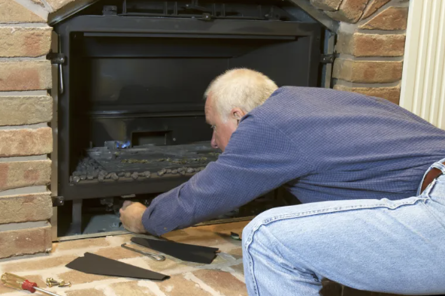We’re still in the middle of a long winter, and you’re probably still enjoying relaxing evenings by a warm fire. After a lot of use and as spring approaches, you might want to start thinking about how to maintain your wood burning fireplace to keep it working safely and efficiently for many years to come. ServiceMaster of Baltimore has seen what can happen if a fireplace isn’t properly maintained, so follow these tips to keep your home safe and warm.
1. Have Your Fireplace Professionally Cleaned Once A Year
It is recommended to have your fireplace and chimney professionally cleaned and inspected at least once a year, or after about 80 fires. Ash and soot builds up in the firebox and chimney over time, combining with moisture in the air to form a hardened substance called creosote. If not removed, it can lead to chimney fires, which can cause explosions and serious damage. Creosote is highly flammable and difficult to remove without commercial-grade products and techniques, which is where a professional chimney sweep comes in.
A professional can also visually inspect the structure and ensure there are no cracks or hidden problems you may not notice that could put your home at risk of a disaster. Wood burning fireplaces are the cause of thousands of home fires every year.
2. Remove Old Ashes
If you’re using your fireplace regularly, ashes quickly build up at the bottom and along the sides of the firebox. It’s important to remove old ashes at the end of the season as well as periodically during the heating season, keeping the ashes to a depth of less than two inches.
While you may think removing ashes after every use is best, the Chimney Safety Institute of America recommends leaving an inch of ashes in the bottom of the firebox because it increases the heat of the burn, leading to a cleaner burn. A clean burn reduces the likelihood of creosote buildup in the chimney. At the end of the heating season, remove all of the ashes until you’re ready to use the fireplace again in the fall.
3. Check the Chimney Cap and Damper
Homeowners should regularly inspect the damper, which is the vent inside the chimney that directs smoke away from the home. If it will not open, it needs to be repaired before using the fireplace, because smoke and carbon monoxide will be trapped and redirected into the home. Keeping it closed when the fireplace is not in use prevents drafts from entering and making the room colder.
You will also want to examine the chimney cap, which in most homes is a wire mesh screen that keeps animals and debris from blocking the chimney. If you don’t use your fireplace regularly, make sure there are no obstructions like an animal nest or excess debris that could block airflow and pose a safety hazard.
Fire Damage Restoration Professionals in Baltimore
ServiceMaster of Baltimore is a locally owned, family owned business that has served Baltimore and surrounding counties for more than 30 years. We specialize in emergency services and clean up after a variety of disasters, including fire damage. Call us at 410‐780‐1700 any time for your disaster restoration needs.


